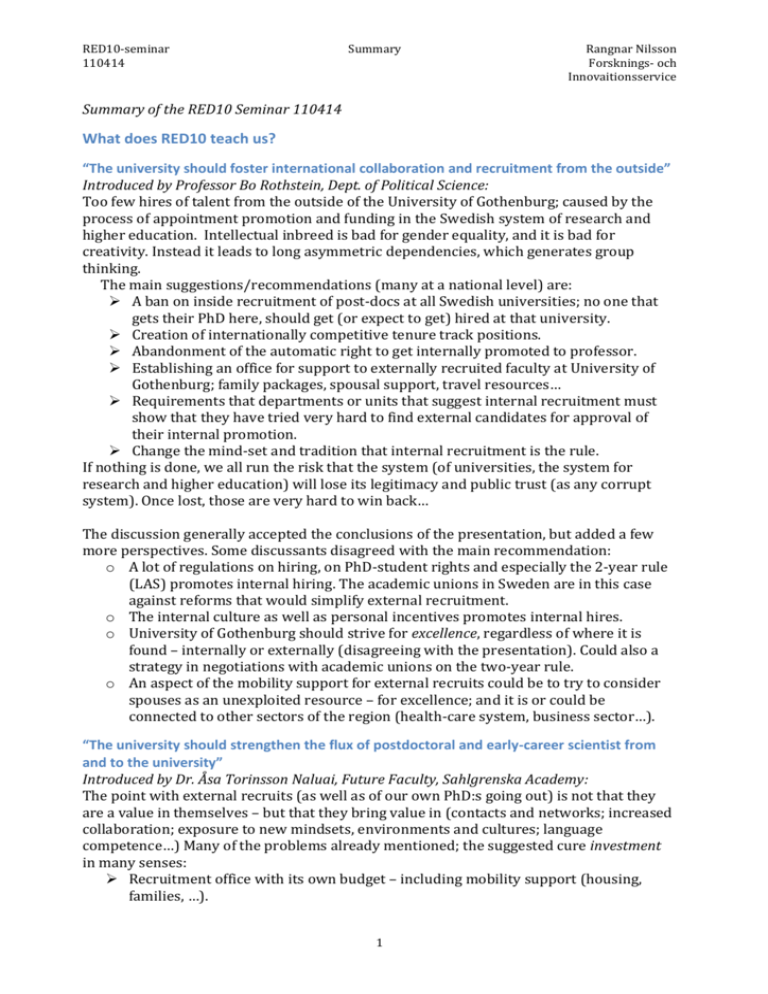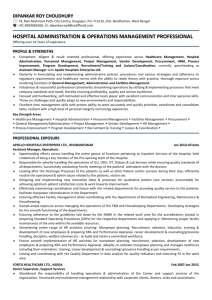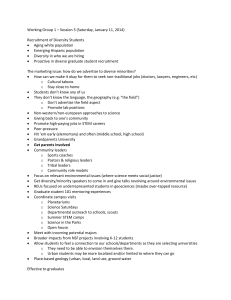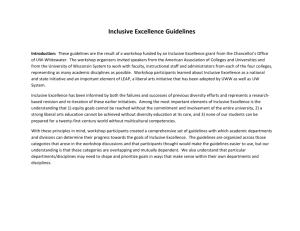Introduced by Professor Bo Rothstein, Dept. of Political Science
advertisement

RED10-seminar 110414 Summary Rangnar Nilsson Forsknings- och Innovaitionsservice Summary of the RED10 Seminar 110414 What does RED10 teach us? “The university should foster international collaboration and recruitment from the outside” Introduced by Professor Bo Rothstein, Dept. of Political Science: Too few hires of talent from the outside of the University of Gothenburg; caused by the process of appointment promotion and funding in the Swedish system of research and higher education. Intellectual inbreed is bad for gender equality, and it is bad for creativity. Instead it leads to long asymmetric dependencies, which generates group thinking. The main suggestions/recommendations (many at a national level) are: A ban on inside recruitment of post-docs at all Swedish universities; no one that gets their PhD here, should get (or expect to get) hired at that university. Creation of internationally competitive tenure track positions. Abandonment of the automatic right to get internally promoted to professor. Establishing an office for support to externally recruited faculty at University of Gothenburg; family packages, spousal support, travel resources… Requirements that departments or units that suggest internal recruitment must show that they have tried very hard to find external candidates for approval of their internal promotion. Change the mind-set and tradition that internal recruitment is the rule. If nothing is done, we all run the risk that the system (of universities, the system for research and higher education) will lose its legitimacy and public trust (as any corrupt system). Once lost, those are very hard to win back… The discussion generally accepted the conclusions of the presentation, but added a few more perspectives. Some discussants disagreed with the main recommendation: o A lot of regulations on hiring, on PhD-student rights and especially the 2-year rule (LAS) promotes internal hiring. The academic unions in Sweden are in this case against reforms that would simplify external recruitment. o The internal culture as well as personal incentives promotes internal hires. o University of Gothenburg should strive for excellence, regardless of where it is found – internally or externally (disagreeing with the presentation). Could also a strategy in negotiations with academic unions on the two-year rule. o An aspect of the mobility support for external recruits could be to try to consider spouses as an unexploited resource – for excellence; and it is or could be connected to other sectors of the region (health-care system, business sector…). “The university should strengthen the flux of postdoctoral and early-career scientist from and to the university” Introduced by Dr. Åsa Torinsson Naluai, Future Faculty, Sahlgrenska Academy: The point with external recruits (as well as of our own PhD:s going out) is not that they are a value in themselves – but that they bring value in (contacts and networks; increased collaboration; exposure to new mindsets, environments and cultures; language competence…) Many of the problems already mentioned; the suggested cure investment in many senses: Recruitment office with its own budget – including mobility support (housing, families, …). 1 RED10-seminar 110414 Summary Rangnar Nilsson Forsknings- och Innovaitionsservice Flexible mobility window: time abroad; communication technology makes collaboration and interaction over large distances more possible; at what stage in the career to be mobile. Planned positions available for incoming researchers to apply for. Implementation of transparent recruitment criteria (not regulated under a set of informal criteria); more influence of external review. Marketing of University of Gothenburg. Securing the quality of research training. Promote networking and collaboration junior-senior colleagues. Promote EU applications for mobility. Involve the new generation of researchers in decision making. Create (and reinforce) an action plan for strengthening the flux of postdoctoral and early career scientists from and to the university! The discussion added some perspectives and comments, there was especially different views on the forms required for the generally valued mobility: o Money should be used as an incentive for external hiring in the strive for excellence (from in- or outside of the university) to counter the fact that internal recruitment is a lot cheaper. o To define the aim as “excellence” (regardless of internal or external) brings in a serious risk of defining what it means according to what you want! o Serious redundancy or dilution in the system; to focus the resources on real talent could help us become internationally competitive. o Important deficiencies in management competence and training in university leadership worldwide and at all levels; visions and goals has to come from the bottom and up, in detail. o Connections to the Scandinavian welfare society; we have to convince people not to leave their comfort zones – but to expand them! Also lock-in-effect of the welfare system in Sweden; impossible to get day care for a child younger than a year, this is something the university could offer. o The seminar had an animated discussion on the meaning of flexibility – is it or can it be enough to go abroad for shorter periods of time, and collaborate and communicate using modern technology – or should you be required to stay abroad for a couple of years? Different perspectives from different generations of researchers? o The university need an analysis of the RED10 and the factors conditioning the outcome; what sectors of research will intrinsically not be defined as excellent given the criteria – for instance research related to (societally important) practices of different kinds; care, fine art, educational sciences, social work… Close to local activities. How should this kind of quality be defined – if not a different kind of excellence? This point was also questioned later – is it really not possible to do excellent research on problems defined in close collaboration with society? “The university should review the departmental and faculty structure and, where appropriate, reduce the number of highly specialized and under-staffed research groups, and should within the university foster the disseminiation of best practice in relation to research and research planning” Introduced by Dr. Lena Eriksson, Dept of Philosophy, Linguistics and Theory of Science 2 RED10-seminar 110414 Summary Rangnar Nilsson Forsknings- och Innovaitionsservice A translation was suggested of the third recommendation of the evaluators, proposing that the point really is to identify ”research inactivity” to be able to reduce the dead weight. Then the presentation commented on the logics and (sometimes perverted) effects of standardisation in and of science and research, to interpret the reasons for or background to the inactivity claim. The aim was to address the notion of research activity as defined by the evaluation matrix. A few fundamental difficulties of the audit culture implemented in science was pointed out; the tension between comparability and autonomy (by the evaluation defined as uniqueness). the normative and formative effects of the evaluations. the problem of relevance, that is very hard to put into the evaluation matrix. The main risk to get a research system streamlined and utterly conservative – rather than autonomous and innovative. New forms of practices cannot perform inside a set matrix of evaluation. Make the evaluation game transparent and explicit – try not to blur the system. Think through how you use the definition of excellence – and all the consequences. Offer mentorship and training in how to play the game inposed. This could reduce the problem of perceived research inactivity (as well as closing down certain fields that intrinsically does not score in the given matrix) without the more extreme streamlining or conservative destructive effects. Also introduced by, and Professor Gunnar Nyman, Dept. of Chemistry The presentation suggested some characteristics of really successful research universities in the world; A broad spectrum of arenas for informal meetings (faculty lunches, coffee rooms, social gatherings). Mentors at all levels. New ideas (often from external faculty) should be picked up and carried further at departments, faculties and at the university as an organisation; picking up bestpractices to spread. Local strategic plans and action plans for research quality through; recruitment policy; working conditions (including adequate start-up funding for new staff; policies for teaching loads and administrative work, sabbaticals…); research in general; teaching; outreach; administration. all designed to support excellence in research The following discussion added a few points: o Has the loss of legitimacy led to a perceived loss of quality and excellence, rather than a real loss? o We should work on bridging the gaps between research environments, areas and organisations; primarily Chalmers – university of Gothenburg, but also in other respects. o Is the standard for promotion at some departments to low? In some fields the conditions for external evaluation are less objective and subject to departmental internal preferences. o Also academic practices that doesn’t fit the excellence profile of the evaluation system, can still use it as a wake-up call for strategic work – to reform practices 3 RED10-seminar 110414 Summary Rangnar Nilsson Forsknings- och Innovaitionsservice and to find suggestions for developing the system to measure a more relevant spectrum of aspects. Experiences from the research evaluation at Uppsala University Presented by Per Andersson, Project Coordinator of the KoF evaluations of 2007 and 2011 The purposes of the evaluation to identify strong areas and successful groups; facilitate renewal; enhance quality; initiate new programs. Characteristics of the evaluations have been: Emphasis on the department visits from the external evaluators (among the summaries and visions from the departments, compilation of existing databases, subject-specific assessments nationally and internationally, bibliometry). On the second KoF the follow-up on recommendations and conclusions of the first round. Four quality ratings (in the first round, one added at the bottom in 2011); Top quality or world-leading research; Internationally high standard; Internationally recognized standard; Acceptable standard; (insufficient). New features in the second round: a double bibliometric standard (ISI and Norwegian model); a follow-up of the first round; a bench-mark assessment. Many of the concerns of the KoF-evaluators duplicate the major issues focused by the RED10-panels: Too much publication in Swedish in some areas. Low mobility. Low level of competition. The main differences between the KoF and RED: The emphasis put on the site visits of the evaluators. Fewer grades A comparison with Helsinki was also made; they’re on their third round of evaluations; 1999, 2005 and now in 2011; the results are getting better, probably partly because the researchers and departments are learning the game. The issue of a national evaluation system for research activities at universities was suggested. The central question is if we, as a university, or as a community of academic institutions, could influence a national evaluation system, if one were to be proposed? The presentation opened further questions: o What has been done to meet the recommendations; many issues were already handled, many departments and units were already on the right track even before the evaluation, but the work has to be done at the faculty and department level – and the ambition and readiness has varied. o The level of detail in the second round of evaluations higher; evaluators asked to asses both research groups, departments, faculties and the university level when it comes to actions and reactions in regard of the conclusions and recommendations of the first KoF. Actions or lack of actions will be connected to the outcome. o Financial support from the university level to units for actions based on the recommendations; not a fixed algorithm according to the result or the actions, but there were funds redistributed according to the evaluation and the work with the central conclusions. o Transparancy; the central aim, to find the best or the good research going on and future research strands to support (extra funding), was announced both to the evaluators and to the people that were to submit the self-evaluations. 4









